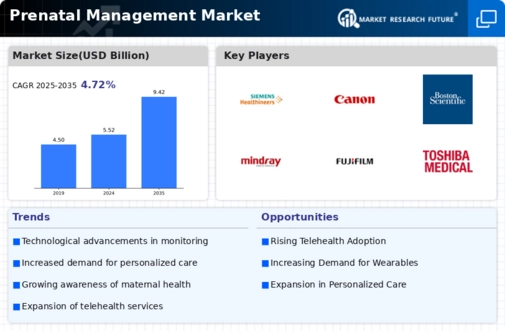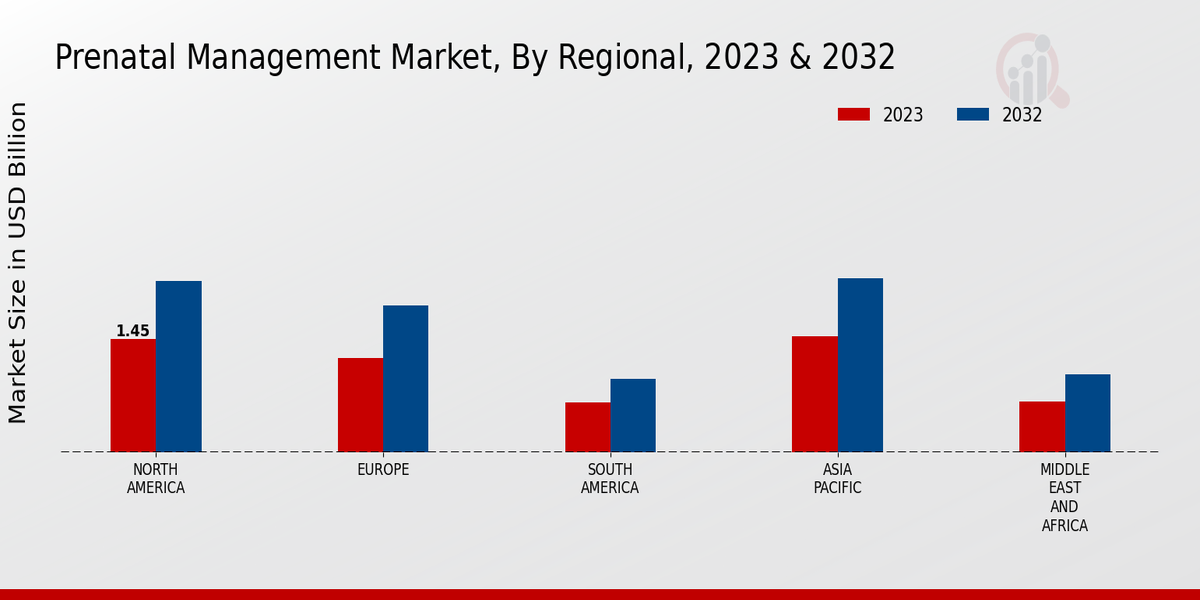Market Growth Projections
The Global Prenatal Management Market Industry is poised for substantial growth, with projections indicating an increase from 5.52 USD Billion in 2024 to 9.42 USD Billion by 2035. This growth trajectory suggests a compound annual growth rate (CAGR) of 4.98% from 2025 to 2035. Various factors contribute to this optimistic outlook, including rising awareness of maternal health, technological advancements, and government support for prenatal care. The market's expansion reflects a broader commitment to improving maternal and child health outcomes globally, emphasizing the importance of prenatal management in ensuring healthy pregnancies.
Increase in High-Risk Pregnancies
The rise in high-risk pregnancies is a significant factor driving the Global Prenatal Management Market Industry. Factors such as advanced maternal age, pre-existing health conditions, and lifestyle choices contribute to the increasing prevalence of high-risk pregnancies. This trend necessitates specialized prenatal care and monitoring, leading to a greater demand for advanced prenatal management services. Healthcare providers are adapting to these needs by offering tailored services and interventions. As the market evolves, it is anticipated that the value will grow from 5.52 USD Billion in 2024 to 9.42 USD Billion by 2035, indicating a CAGR of 4.98% from 2025 to 2035.
Government Initiatives and Support
Government initiatives aimed at improving maternal and child health significantly influence the Global Prenatal Management Market Industry. Many countries have implemented policies that promote access to prenatal care, including subsidized healthcare services and educational programs for expectant mothers. For example, various public health campaigns encourage regular prenatal check-ups, which are essential for monitoring the health of both mother and child. Such initiatives not only enhance the uptake of prenatal services but also contribute to the overall growth of the market, which is expected to expand from 5.52 USD Billion in 2024 to 9.42 USD Billion by 2035, reflecting a CAGR of 4.98% from 2025 to 2035.
Rising Awareness of Maternal Health
The increasing awareness surrounding maternal health is a pivotal driver for the Global Prenatal Management Market Industry. Educational campaigns and healthcare initiatives have led to a heightened understanding of the importance of prenatal care among expectant mothers. This awareness is reflected in the growing number of women seeking prenatal services, which is projected to contribute to the market's expansion. As of 2024, the market is valued at 5.52 USD Billion, with expectations to reach 9.42 USD Billion by 2035. This growth indicates a compound annual growth rate (CAGR) of 4.98% from 2025 to 2035, underscoring the increasing prioritization of maternal health globally.
Technological Advancements in Prenatal Care
Technological innovations play a crucial role in shaping the Global Prenatal Management Market Industry. The integration of advanced diagnostic tools, telemedicine, and mobile health applications has transformed prenatal care delivery. For instance, the use of non-invasive prenatal testing (NIPT) has gained traction, allowing for early detection of genetic conditions. These advancements not only enhance the accuracy of prenatal assessments but also improve accessibility for women in remote areas. As technology continues to evolve, it is likely to drive further growth in the market, aligning with the projected increase in market value from 5.52 USD Billion in 2024 to 9.42 USD Billion by 2035.
Growing Demand for Personalized Prenatal Care
The shift towards personalized prenatal care is emerging as a key driver in the Global Prenatal Management Market Industry. Expectant mothers increasingly seek tailored healthcare solutions that address their unique needs and preferences. This trend is facilitated by advancements in genetic testing and personalized medicine, allowing for customized prenatal care plans. Healthcare providers are responding to this demand by offering more individualized services, which enhances patient satisfaction and outcomes. As the market adapts to these preferences, it is projected to grow from 5.52 USD Billion in 2024 to 9.42 USD Billion by 2035, with a CAGR of 4.98% from 2025 to 2035.



















